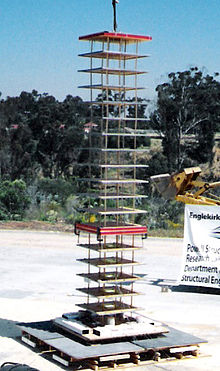Earthquake protector
| Educational level: this is a research resource. |
Earthquake protector is a type of base isolation intended for protection of building and non-building structures against potentially damaging lateral impact of strong earthquakes [1].

Heavy damping mechanism sometimes incorporated in vibration control technologies and, particularly, in base isolation devices, may be considered a valuable source of suppressing vibrations thus enhancing a building's seismic performance. However, for the very pliant systems such as base isolated structures, with a relatively low bearing stiffness but with an high damping, the so-called "damping force" may turn out the main pushing force at a strong earthquake [2]. This finding created a theoretical ground in earthquake engineering for a damping-disengaged base isolation technology called Earthquake protector [3].

A shake-table video of concurrent shake-table experiments with two identical and kinematically equivalent to their 12-story prototype building models is presented at [4]. The right model is resting on Earthquake Protectors, while the left one, caught at the time of its crash, is fixed to the shake-table platen.
Analytical software
[edit | edit source]Analytical software called EPET or Earthquake Performance Evaluation Tool enables concurrent virtual experiments on the same building models with any sliding type of base isolation, including Earthquake protector, and without.
| Look up Earthquake protector in Wiktionary, the free dictionary. |
| Wikibooks has a book on the topic of Seismic fitness. |
See also
[edit | edit source]References
[edit | edit source]- ↑ Valentin Shustov (2010), "Testing of a New Line of Seismic Base Isolators," https://nees.org/resources/770
- ↑ Base Isolation: Promise, Design & Performance
- ↑ SGER: Testing of a New Line of Seismic Base Isolators
- ↑ Earthquake Protector: Shake Table Crash Testing

